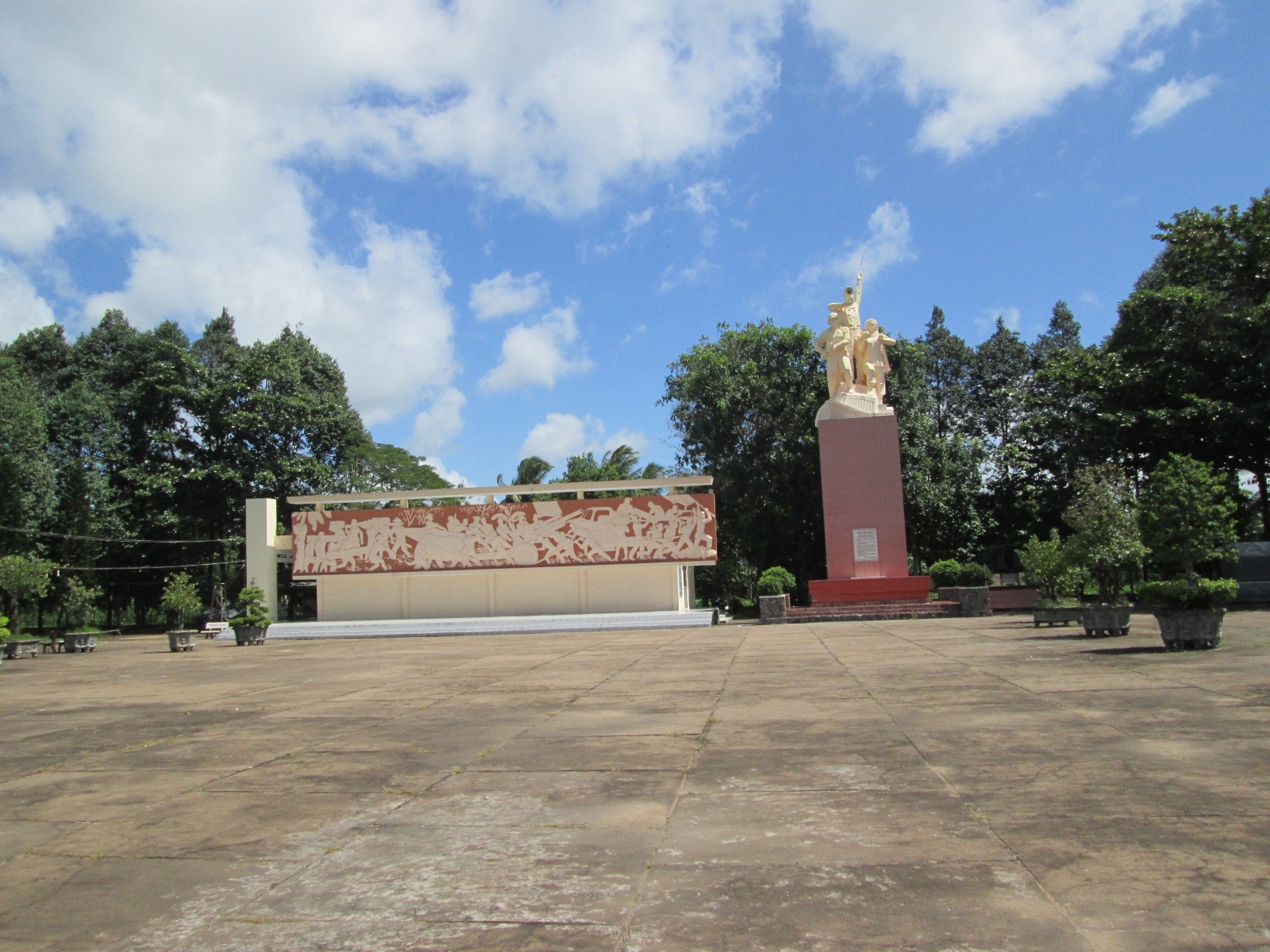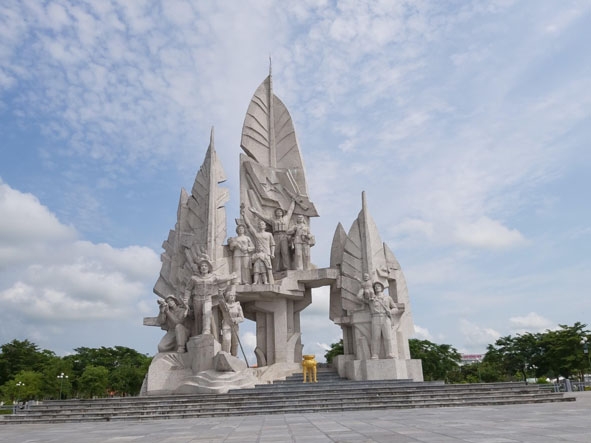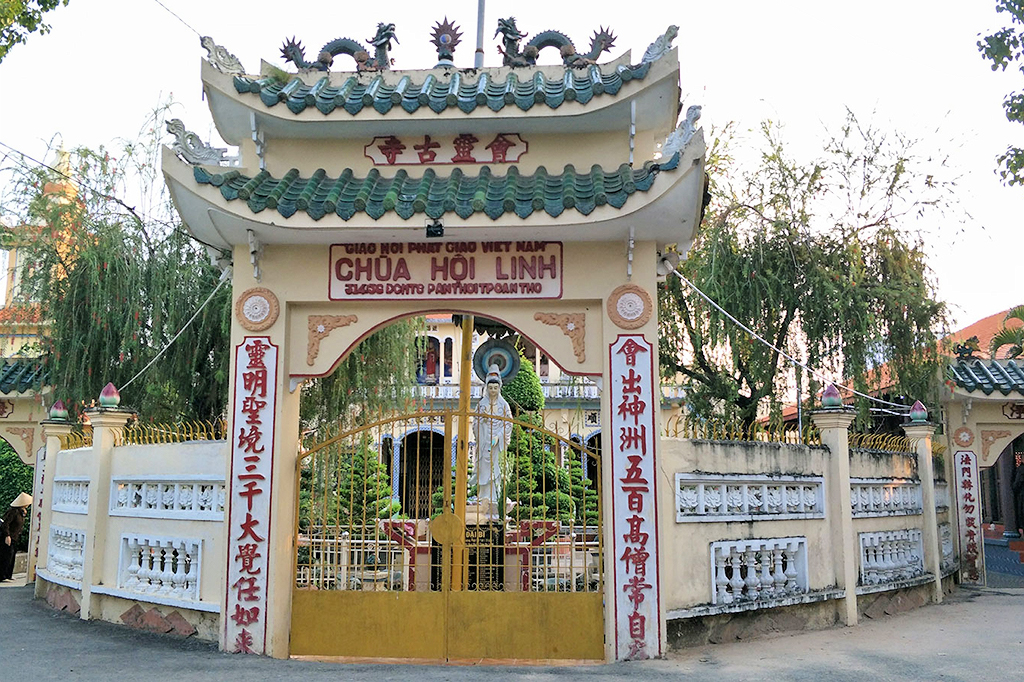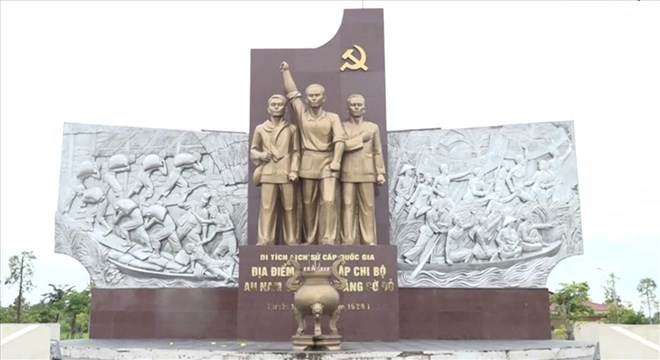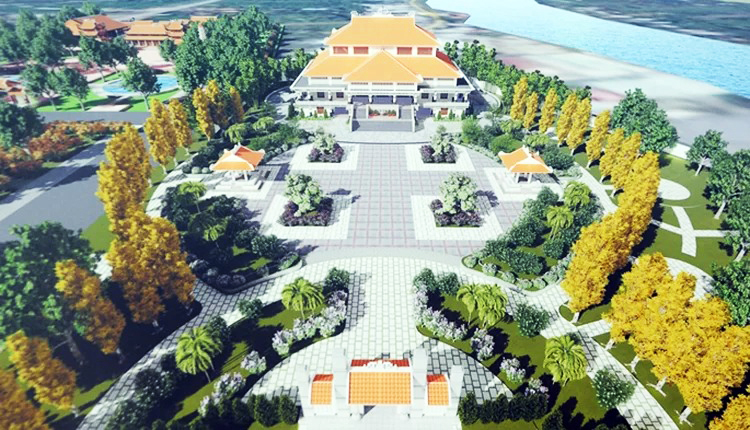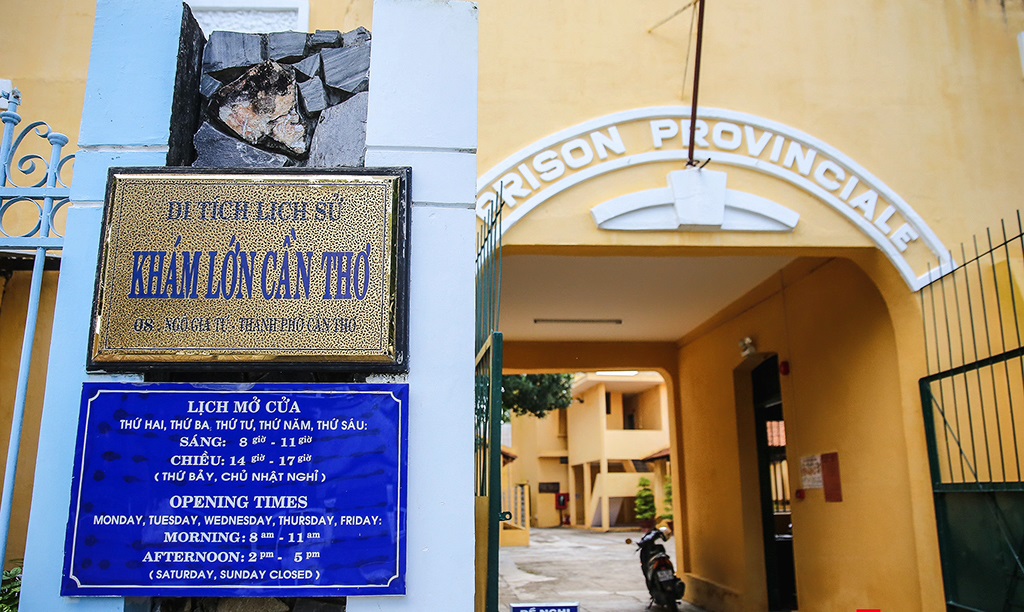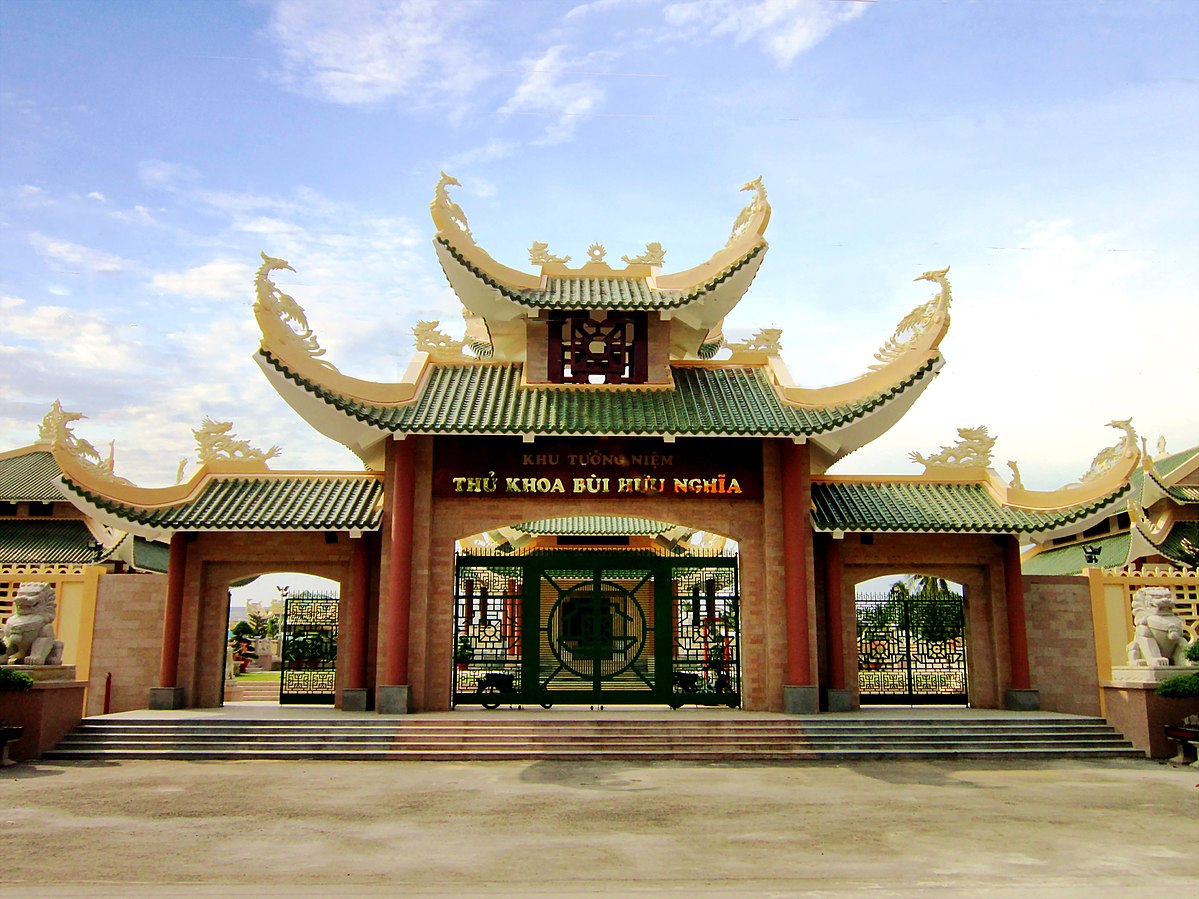Relic point Vietnam
Việt NamTam Vu Victory Relic
Tam Vu Victory Relic Area is located in Xeo Cao hamlet, Thanh Xuan commune, Chau Thanh A district, Hau Giang province. The glorious victories of the four ancient Tam Vu battles that took place on the Cai Tac - Rach Goi road section, less than 5km, were a brilliant highlight in the resistance war against the French colonial invaders of our army and people. After September 23, 1945, the Saigon - Gia Dinh army opened fire against the invading French colonialists, opening the Southern resistance war, then on October 30, 1945, the Can Tho army and people became heroic in their resistance against the French colonialists. recaptured Can Tho. After 90 days of siege and attrition, destroying the French army in Can Tho town, Le Binh's suicide squad disguised itself and gathered at the French command post in Cai Rang on the morning of November 12, 1945. Wounding many enemy soldiers, including the wounded officer of Rouen, terrified the French soldiers. With courage, the Republican Guard unit commanded by comrade Nguyen Dang on January 20, 1946, attacked the enemy's military convoy on Tam Vu Highway, destroyed 2 military vehicles, and killed a number of enemy soldiers. including Dessert, commander of the French expeditionary force in the West, one of five high-ranking French officers on the Indochina battlefield. We confiscated 10 guns, including 2 medium machine guns. The Battle of Tam Vu 1 had a very important meaning, this was the first victory of our armed unit against enemy motor vehicles, opening the door for the next battles on the Can Tho battlefield. Less than a year later, Can Tho's army and people continued to win the battle of Tam Vu 2, on November 12, 1946, commanded by comrade Ngo Hong Gioi, ambushing the enemy's military convoy on Tam Vu Highway. , destroyed 3 vehicles, killed 60 French and Le Duong soldiers, collected 60 guns of all kinds and many other military equipment and supplies. After the day of "National Resistance", implementing the directive "All People's Resistance" of the Party Central Committee's Standing Committee (December 19, 1946) and the call of beloved Uncle Ho (December 20, 1946). The all-people and comprehensive resistance war has developed strongly, Can Tho's army and people have achieved many victories, especially the activities of the "Party Assassin" teams, Rangers, and armed police to destroy enemies and evildoers. The storm in the inner city of Can Tho made people confused and afraid. At this time, the Tam Vu 3 battle took place on May 3, 1947, commanded by Minister Huynh Phan Ho, also on the old Tam Vu route. Our army and people destroyed 6 military vehicles, killed and injured nearly 200 French soldiers, and captured 8 machine guns, many guns and ammunition of all kinds, as well as military equipment and supplies. The Battle of Tam Vu 3 was a victory of heaven, earth, and people. When we returned to camp at Lang Ham to prepare for the Battle of Tam Vu 3, a squad of Khmer soldiers came in to cut down trees and were forced to destroy them. Our troops withdrew as a diversion, only 10 days later they returned to hide their troops, continuing to fight the Tam Vu 3 battle without being exposed, because the people protected the soldiers to defeat the enemy. Victory after victory, just one year later, the beautiful coordination of three types of troops (main force, local army and guerrilla militia) created a heroic miracle, continuing to win the battle of Tam Vu. 4, took place on the afternoon of April 19, 1948, under the command of Minister Tran Van Giau and Chief of Staff Vo Quang Anh, our army used the tactic of occupying and attacking, destroying 14 enemy military vehicles, killing Nearly 200 French soldiers, including one Quang Ba, collected many guns and ammunition, especially the 105mm cannon for the first time in the country, resounding throughout the Indochina battlefield. With the profound meaning and scale of victory of the 4 Tam Vu battles, the golden book of our nation's revolutionary tradition against invaders has become even more brilliant. Therefore, the Ministry of Culture and Information recognized the Tam Vu victory site as a national historical-cultural relic on January 25, 1991. Source: Hau Giang Province Electronic Information Portal
Can Tho 6054 view
Uncle Ho's Temple in Luong Tam Commune
Uncle Ho's Temple relic is located in hamlet 3, Luong Tam commune, Long My district, Hau Giang province. The people of the South in general, the people of Hau Giang - Can Tho and Long My in particular, the image of beloved Uncle Ho is in the hearts and minds of every person, although thousands of kilometers away from the capital Hanoi, always look towards Uncle Ho and his beloved capital with firm belief to fight and defeat the invading enemy. Hearing the news of Uncle Ho's death on September 2, 1969 was a common pain and a great loss for the entire Vietnamese people; Especially the people of the South have not had time to welcome Uncle Ho to visit. To repay Uncle Ho's kindness and meet the wishes of the people of Luong Tam commune; The Commune Party Committee, led by comrade Lu Minh Chanh (Hai Chanh), Secretary of the Commune Party Committee, decided to set up an altar to Uncle Ho right at the Commune Party Committee Office. Comrade Le Van Thong, member of the secretary, was assigned the task of releasing photos of Uncle Ho setting up an altar and sewing funeral ribbons to organize the memorial service. The next day, the memorial service was solemnly held with the full presence of leaders of departments, branches, organizations of communes, hamlets, main army units, and local soldiers stationed near the base. Commune officials, along with a large number of people in the commune, came to attend the ceremony with infinite sadness, commemorating and remembering Uncle Ho's gratitude to heaven and earth and promising Uncle Ho the determination to defeat the American invaders. Responding to the call of the Party Central Committee - turning suffering into revolutionary action, Can Tho's army and people continuously attacked the enemy in all areas of the province. During the week of Uncle Ho's mourning, the army and people of Can Tho province launched an attack on 34 military targets, destroying nearly 400 enemies. In Luong Tam commune alone, our army and people destroyed the posts: Vam Cam, To Ma, and Duong Dao (severely damaged). Over 40 enemy soldiers paid for their crimes and many others were injured. Right after the National Funeral Day, the leaders and some veteran revolutionary comrades and elders in the commune discussed and came to a decision: to build a temple to Uncle Ho in Hamlet 3, at the intersection of the highway. This is the most convenient place for people in the commune and other areas to easily visit Uncle Ho by both waterway and road. In the summer of 1972, the US puppet launched many large-scale raids, concentrating bombs and artillery on fiercely attacking the Long My area. The Commune Party Committee was destroyed by American artillery bombs and had to be moved to another place. Uncle Ho's altar was rebuilt and the holidays to celebrate Uncle Ho were held every year (birthday, death anniversary and Lunar New Year). In addition, people in the area worship Uncle Ho and celebrate his death anniversary at home. After the day of peace, from the earnest wishes of the Party Committee and people of Luong Tam commune, they wished to rebuild Uncle Ho's Temple at the planned location during the resistance war against the US, at the intersection of the highway, hamlet. 3, Luong Tam commune and with the approval of the leaders, branches, levels and people inside and outside the locality actively contributed their human and material resources, with a heart of love for Uncle Ho and this is a practical memorial project to welcome Uncle Ho. Celebrate the 100th anniversary of Uncle Ho's birth. (May 19, 1890 - May 19, 1990). Uncle Ho's temple was built in 1990, with a scale of nearly 2 hectares. Uncle Ho's temple was built with a national, solemn and respectful architectural style. On the occasion of the 107th anniversary of Uncle Ho's birth (May 19, 1890 - May 19, 1997), provincial leaders continue to direct the construction of an exhibition house to introduce Uncle Ho's childhood and revolutionary life. Uncle, this is the second category after the Temple. With that meaning, the Ministry of Culture and Information recognized Uncle Ho's Temple as a National historical relic. Source: Long My District Electronic Information Page
Can Tho 4625 view
Historical relic of Chuong Thien Victory
The Chuong Thien Victory historical relic is distributed in 2 locations: area 3, ward 5, Vi Thanh city and hamlet 1, Vinh Vien commune, Long My district, Hau Giang province. Chuong Thien used to be a province, established by the Saigon puppet regime on December 24, 1960, including Long My and Vi Thanh districts; This place is an important waterway traffic hub to go to the provinces of Can Tho, Soc Trang, Bac Lieu, U Minh, and Rach Gia. The enemy considers Chuong Thien a remote defense line to protect the headquarters of the 4th tactical region (located in Can Tho city), a shield to prevent our main forces from attacking, and a springboard to attack the base. U Minh revolution. Therefore, Chuong Thien became an important strategic area for both us and the enemy. For us, Chuong Thien is a solid belt to protect U Minh base, a springboard to attack Can Tho, Soc Trang, Bac Lieu, and Rach Gia. This place is also a large rear base, storing people and materials to serve the resistance war. After the Paris Agreement (1973) took effect, the Saigon puppet government and the US imperialists still intended to destroy the southern revolution, eliminate the liberated area with plans to pacify, encroach... Recognize The enemy's situation and plots, our army was prepared to deal with. During 11 months (from January to November 1973), our army and people stubbornly held on, fought bravely, and maintained the area. The enemy's plan to pacify Chuong Thien failed completely. The victory of Chuong Thien in 1973 is vivid proof of the correct, bold, and timely policy of the army and people of the Mekong Delta. This victory also contributed to creating one of the important foundations for Resolution 21 to be born, creating a premise for the change of direction of the Southern revolution, towards the victorious General Offensive and Uprising in 1975. In order to promote the value of historical relics and educate revolutionary traditions, the relic site of area 3, ward 5, Vi Thanh city and the relic site of hamlet 1, Vinh Vien commune, Long My district were chosen as locations. commemorating the victory of Chuong Thien of the army and civilians of area 9. At the location of area 3, ward 5, Vi Thanh city, Hau Giang province: According to the approved master plan, this relic site has an area of 44,303.7m2, with the following items: current exhibition area (1024m2), outdoor display area, monument, ceremony yard and a number of other ancillary items. Currently, many artifacts related to the relic site, such as more than 100 documentary photos of a number of battles to destroy Cai Nai sub-region, Quang Phong weak area, and destroy Roc Dua, Cai Son, Cai Cao stations... ; 117 artifacts, including weapons, military equipment, tanks, airplanes..., have been received and stored at the artifact warehouse of Hau Giang Provincial Museum. At the location of hamlet 1, Vinh Vien commune, Long My district, Hau Giang province: In 1998, Can Tho province (old) planned a total area of 58,000m2 of land to build the following items: exhibition house (900m2) , meeting house, internal courtyard and some other auxiliary items. The 75-round victory of the enemy battalion to pacify the invasion of Chuong Thien after the 1973 Paris Agreement, not only defeated the tactics, but also collapsed the US-Wei's strategic intention of gaining strength in the political solution. contributed to creating a turning point, defeating the enemy's strategy of Vietnamizing the war. With the special values of the monument, the Prime Minister decided to classify the Chuong Thien Victory Historical Monument as a special national monument on December 9, 2013. Source: Department of Cultural Heritage
Can Tho 4498 view
Ancient Spirit Association
Hoi Linh Pagoda, also known as Hoi Linh Co Tu, belongs to the Northern sect - located on an area of 6,500m2 at 314/36 Cach Mang Thang Tam Street (about 200 meters from the road), Bui Huu Nghia Ward, Binh Thuy district, Can Tho city. Hoi Linh Pagoda was founded on the full moon day of the second month of the year Dinh Mui 1907, following the Lam Te Zen sect. Initially, the pagoda was built simply with tree pillars, walls and thatched roof. The pagoda's door faced the Hau River, named "Hoi Long Tu". Because the pagoda is located at the top of a small canal, it is also called Xeo Can pagoda. Architecturally: the pagoda has a complete three-entrance gate, main hall, back hall, lecture hall. The main gate extending forward has two layers of roof, the tiled roofs of the main gate and the two side gates are all curved roofs covered with beautiful blue yin and yang tiles. The main gate's tiled roof is decorated with two dragons and pearl paintings, a type of decoration very common in Southern temples and communal houses. The main hall is divided into three compartments and has one floor. The floor is divided into three rooms to worship Buddha Shakyamuni, Guanyin, and Ksitigarbha. The cement roof is molded into the shape of fish scales. On the top are lotus buds, wine gourds, dragon-shaped blades, and curved flowers and leaves. The back hall is 144 m² wide, in the middle is the Fatherland altar with a photo of President Ho Chi Minh. This place is also used as a reception area. Next to that is the lecture hall, where sutras and sermons are preached... In addition to its cultural and artistic features, the pagoda also records a historical mark associated with the two resistance wars against the French colonialists and the American Empire invaders of Can Tho people in particular. Since 1941, Hoi Linh Pagoda has become a secret base of the revolution. The monks, monks, nuns and Buddhists in the area protected, supported and nurtured many revolutionary leaders. In 1946, to protect the revolutionary base here, Venerable Thich Phap Than decided to burn part of the main hall. The pagoda's sacrifice demonstrates the spirit of patriotism, protection of officials, protection of the revolutionary base, of the monks, monks and nuns. After the Geneva Accords, Hoi Linh Pagoda continued to be a solid revolutionary base and protected the safety of many revolutionary cadres who remained active. The pagoda was a secret place where many meetings were held to deploy the policies of the revolution and the content of public struggles with the enemy. The enemy suspected that Hoi Linh Pagoda was a "undercover Viet Cong" base, and once sent a platoon of soldiers to surround the pagoda. Unable to find any evidence, the enemy arrested Venerable Thich Phap Than along with 6 monks and 6 Buddhists and detained them for investigation in Phu Loi prison for 3 years. The puppet government used all tricks to seduce, bribe, and brutally torture, but Venerable Phap Than and the monks and Buddhists all maintained their integrity and loyalty to the revolution. The revolutionary base at Hoi Linh Pagoda was still safe and continued to house and protect revolutionary cadres until April 30, 1975, liberating the South and reunifying the country. On June 21, 1993, the Ministry of Culture and Information recognized Hoi Linh Pagoda as a National Historical and Cultural Monument, a revolutionary base from 1941-1975. In particular, the State awarded the First Class Resistance Medal to Hoi Linh Pagoda and recognized martyr Duong Van De (aka Venerable Thich Phap Than) who sacrificed in the cause of fighting against the US to save the country. Source: Can Tho Tourism
Can Tho 3921 view
Pothisomron Temple
Pothi Somron Pagoda is an ancient Khmer pagoda located on the O Mon river, in Chau Van Liem ward, O Mon district, Can Tho city. The pagoda was recognized as a city-level historical and cultural relic in 2006. In the pagoda's grounds there are many trees, including a tree called Somron, so the pagoda was named Somron. Initially, in 1735, Pothi Somron Pagoda was only built with simple materials such as leaves and bamboo. By 1856, the pagoda was built with precious woods such as spokes, ca ca, Thao lao and covered with fish-scale tiles. 100 years later, the pagoda was degraded, Venerable Thach Khieng - Abbot of the pagoda from 1950 to 1988 went to Phnom Penh to request a new design from famous architects of Cambodia, on the basis of preserving traditional architecture. system. Construction on the new pagoda began in June 1950 and was completed in 1952. This architecture is kept until now. The pagoda has one side facing the gate of the Khmer Theravada Buddhist Academy, the other gate is close to the gently flowing O Mon River with a cool water wharf. The main hall is a prominent building in the architectural complex of Pothi Somron Pagoda, built in the East direction. Khmer people believe that although Buddha is in the Western world, he always looks towards the East to save sentient beings. The steps leading up to the main hall have a sophisticated Buddha statue meditating. On the wall are drawings depicting the life of Buddha presented very vividly. The images of the nymphs Kennâr and the god bird Krud are carved so high as to support the tile roof. The main hall's roof has three overlapping levels, with a dragon image running along the edge of the roof with its tail reaching straight up into the sky. The columns, fences, door frames, roof tops, and walls are all meticulously carved with geometric and water hyacinth patterns. Khmer pagodas all have core towers, but perhaps there are few pagodas that can preserve a more than 200-year-old tower like Pothi Somron Pagoda. The bone tower is right in front of the main hall, built of umbrellas, laterite, and bricks dating back to the 18th century. Inside this tower are the remains of many Buddhists and have been preserved for many generations. According to Venerable Dao Nhu, abbot of the pagoda since 1988, said: some Buddhists asked to rebuild and renew the outside of the tower, but the pagoda did not agree, because this is evidence of the pagoda's history and culture. nation's culture. The pagoda currently preserves many antiques. These are wooden swallow wings made in 1856 carved with images simulating stories about Shakyamuni Buddha, more than 100 sets of Satra sutras (leaf books), 17 wooden statues nearly 200 years old. The Buddha statue in the Center of the Main Hall was carved in 1885. During the two resistance wars against the French and the Americans, Pothi Somron Pagoda supported and sheltered many young people who escaped the military draft of the old regime. Many monks and monks of the pagoda, after returning from secular life, became party members and union members. Typical examples include Mr. Dao Sang, Chief of Police and Mr. Dao Ca, Chairman of the Dinh Mon Commune Resistance Committee in the years 1945 - 1948. For nearly three centuries of existence, the ancient temple is still dignified and pure, many monks have studied here, there are monks with high virtue and great merit, such as: Venerable Dao Nhu, practicing at Pothi Som Rom was 12 years old and became the abbot of the temple. Up to now, Venerable Dao Nhu is making great contributions to the sect and church as the new leader of the Khmer Theravada Buddhist Academy. Today, Pothi Somron Pagoda is the origin of many social and cultural activities launched by the Vietnam Fatherland Front Committee of Can Tho City, the Buddhist Association of Can Tho City and the Department of Culture, Sports and Tourism. Source: Western Travel
Can Tho 5663 view
Thoi An Temple
Thoi An communal house is located in Thoi Trinh A area, O Mon district, Can Tho city. Thoi An communal house was built in the early 19th century, built on a small scale by the people of Thoi Thuan hamlet, Thoi An village, using bamboo materials to worship the god. In 1852, King Tu Duc approved and conferred the title of Thoi An village communal house as "Thanh Hoang's original scene". Since the ordination, the villagers have chosen a location and joined forces to build a spacious new communal house 1km away from the old communal house. That is today's Thoi An Temple. The communal house was built in a rectangular shape, facing east, with a unique artistic architecture, imbued with the traditional architecture of the nation. Like some village communal houses in the Mekong Delta, Thoi An communal house worships "Thanh Hoang Bon Canh" who worships ancestors who openly reclaimed wasteland, established villages, and expanded the village's business. rich and prosperous; worshiping officials and soldiers who sacrificed for the country, worshiping the ancestors who taught vocational skills to the villagers. After the country was unified, the Thoi An Temple Sacrifice Committee set up an incense table to worship President Ho Chi Minh. grand. During the nine-year resistance war against French colonial invaders, Thoi An communal house was also the headquarters of the Provisional Administrative Resistance Committee of O Mon district. Every year, Thoi An people solemnly organize two festivals: Thuong Dien and Ha Dien, praying for good weather and good weather, prosperity and happiness. This is also an opportunity for people to remember heroic martyrs and those who have contributed to their homeland. Having gone through many historical events, Thoi An communal house still stands proudly. This is one of the few remaining beautiful and ancient communal houses in Can Tho City, as well as in the Mekong Delta region. With those values, on November 15, 2004, Can Tho City People's Committee ranked Thoi An communal house as a city-level historical and cultural relic. Source: Can Tho Tourism
Can Tho 4301 view
An Nam Communist Party Red Flag relic site
On the night of November 10, 1929, in a hut across the rice paddies of Co Do plantation (in Thoi Dong village, Thoi Bao canton, O Mon district, Can Tho province), comrade Ha Huy Giap - Member of the Executive Committee of the Special Committee for Security The Southern Communist Party of Hau Giang was assigned by the Special Committee to O Mon in coordination with comrade Nguyen Van Nhung and comrade Bay Nui to establish the An Nam Communist Party Cell, with comrade Ha Huy Giap as Secretary. The Annam Communist Party Cell of the Red Flag Party propagated and campaigned to raise revolutionary enlightenment for a large number of working farmers, guided the fight for their rights, and actively selected the masses to join party organizations. The Party cell quickly promoted the building and development of grassroots party organizations throughout the province to lead the revolutionary movement. The birth of this cell not only promoted the revolutionary movement in Can Tho but also had a strong impact on many localities in the region such as Dong Thap, An Giang... From the first Party cell, many other Party cells were established in the province... Mass organizations of the Party such as the Red Trade Union, the Red Agricultural Association, Youth, and Anti-Imperial Women were also organized in many places. , under the leadership of the party cells, gathered a large number of people and promoted the revolutionary struggle movement. To preserve and promote historical values, the city has invested in building a project to preserve, restore and promote the value of historical relics. Location of the establishment of the An Nam Communist Party Cell of the Red Flag Party with an area of nearly 40,000 square meters. The project was completed and put into use in 2019 right on the old plantation land, which is also the center of Co Do district today. The relic area is built in the style of an open park, with airy space, including items: monuments, reliefs, stele houses, squares, and lotus ponds. On October 31, 2013, the Ministry of Culture, Sports and Tourism decided to classify the location where the An Nam Communist Party Cell of the Red Flag was established as a national historical relic. Currently, the relic site is a place for sightseeing, studying, traditional activities, cultural and artistic activities, and sports for people of all walks of life and tourists from near and far. Source: Can Tho City People's Committee
Can Tho 5732 view
Highway Arc
The historical site of the troop transfer location, the forward military medical station and the weapons cache on the Can Tho arc road is located in My Khanh commune, Phong Dien district, Can Tho city. Vong Cung Highway is nearly 30 km long, connecting National Highway 1A from Cai Rang bridge to Phong Dien district, mostly through communes: My Khanh, Nhon Ai, Tan Thoi, Giai Xuan and ending at Ba Se highway (Phuoc Thoi ward). , O Mon district). Right from the French colonial period, colonial henchmen suppressed and arrested people to work as road builders with a plot to build the road into a defensive belt to protect their headquarters in the inner city of Can Tho. Under the Saigon government regime, the Arc Highway continued to be built as a defensive fence to protect the tactical region IV nerve center, Tra Noc airport and US representative agencies in Can Tho. Tho is both a place to test all the most brutal tricks to wipe out revolutionary bases on the Arc Road, and at the same time serve as a springboard to attack our revolutionary forces at U Minh Base. For us, Vong Cung Highway is both a convenient gateway for roads and waterways, as well as a place to transport and supply food, weapons, necessities, and to house leaders. network for army units, creating a solid connection between the forces of the district, province and the Gathering Area to bring forces into the Arc, attacking the enemy's headquarters in Can city. Poem. During the resistance war against American imperialism, Lo Vong Cung was the place to transfer troops (My Nhon hamlet); Forward Military Medical Station (My Long hamlet); weapons hiding place (My Thuan hamlet) of revolutionary forces. Here, we organized the transportation of food, weapons, necessities to accommodate revolutionary cadres, army units and was a gathering place for revolutionary forces. Therefore, the US imperialists conducted many rounds of artillery strikes, bombarding and destroying the people's homes, fields and gardens, and spraying defoliants to destroy life, with the determination to knock the revolutionary force out of the Ring. Supply and cut communication lines between the revolutionary forces and the people here. Many battles between us and the enemy took place extremely fiercely, with countless blood and bones of soldiers and compatriots who fell on the land of the Arc. But with the tradition of patriotism and absolute belief in the revolution, the people here are not afraid of sacrifices and hardships, but are still determined to stand by, support, feed, and protect the officers and soldiers standing in the fight. fight until the day of national unification, contributing to beautifying the glorious pages of history about the revolutionary struggle tradition of the Party, army and people of Can Tho. Therefore, Can Tho Arc Road is not only a landmark but also has historical significance in Can Tho's resistance war against foreign invaders. In addition to the troop transfer location, the Forward Military Medical Station, and the place where the revolutionary forces' weapons were hidden, this place also left a deep mark of military and civil solidarity associated with the pain, loss, and sacrifice of the soldiers. compatriots and soldiers who have fallen for the Fatherland. On February 7, 2013, the Ministry of Culture, Sports and Tourism ranked the troop transfer location, the Forward Military Medical Station and the weapons hiding place on Can Tho Arc Road during the resistance war against the US as a Historical Relic. National level history. Source: Can Tho historical and cultural relics information page
Can Tho 4391 view
Can Tho Grand Examination
The Can Tho Grand Prison historical relic is currently located at No. 8, Ngo Gia Tu Street, Tan An Ward, Ninh Kieu District, Can Tho City. To serve the ruling apparatus in Can Tho, from 1876 to 1886, the French colonialists promoted the construction of many agencies and offices... including a prison named "Prison Provinciale". The prison was built on an area of 3,762 square meters, adjacent to the Governor's Palace, opposite the Administrative Building and separate from the residential area, people often call it Can Tho Grand Prison. When the Geneva Agreement was signed in 1954, the Saigon government changed the name of Can Tho province to Phong Dinh province, and the Can Tho Grand Prison was renamed the Correctional Center. But no matter what name it is called, Can Tho Grand Prison is essentially a hell on earth - a place where imperialist colonialists imprison and exile our revolutionary soldiers and patriotic compatriots. The Big Examination Gate has an arch shape, on the left of the gate is the office of the on-duty supervisor, on the right is the office and residence of the chief supervisor. The large prison is surrounded by a wall from 3.6m to 5m high, covered with pieces of bottles and barbed wire. At each corner of the wall is a 6m high watchtower with guards and floodlights at night to control prisoners. Inside the large prison, there are 21 collective cells and many solitary confinement cells. Between the prison rows is a large yard for prisoners to sunbathe. In this yard, the colonialists and imperialists also built pagodas and churches to show respect for the prisoners' beliefs and religion. Around 1963, two rows of buildings were built on the yard behind the temple, the ground floor had no walls - for a time it was used as a vocational guidance house for prisoners... The prescribed capacity in each collective cell is only about 30 to 40 people, but sometimes the number of prisoners reaches 70 to 80 people. Especially after the Southern Uprising, the enemy crazy used all tricks to terrorize and take revenge on our people. Many leaders, party members and the masses were imprisoned by the French colonialists at the Can Tho Grand Prison. In addition, the enemy also brought hundreds of people participating in the uprising and leading comrades in the provinces of Soc Trang, Bac Lieu, Ca Mau... here to detain and brutally torture them. Especially during the period when US imperialism used the "Law promulgated by the Republic of Vietnam regime on May 6, 1959 to terrorize and restrain our people, arresting all those suspected of being "Viet Cong", At this time, the number of prisoners in each room sometimes reached more than 100 people. Many prisoners could not endure the regime of imprisonment, torture, and harsh food and had to slowly die in this dark prison. The remaining people were infected with all kinds of diseases: scabies, malaria, typhoid, tuberculosis... For special political prisoners, the enemy was locked up in solitary confinement cells, tortured to the point of paralysis but still alive. loyalty to the Party and the people, keeping integrity until the last breath. Despite extreme torture, the Party comrades in prison still had Party Cells, Party Committees, study activities, and organized struggles with the enemy every hour and every minute, resolutely preserving revolutionary qualities. It is the indomitable fighting spirit and patriotism of political prisoners that has inspired and enlightened the revolution by many prison guards and guards, and they volunteered to be our internal base. Inform political prisoners of our situation and the enemy outside to take precautions or have strategies to fight the enemy in prison. The South was completely liberated, and Can Tho Grand Prison became a deeply engraved evidence of the indelible crimes of colonialism and imperialism. It is here that so many outstanding people from their hometown of Can Tho and neighboring provinces have fallen to contribute to writing the glorious and heroic history of the nation. On June 28, 1996, the Ministry of Culture and Information ranked Can Tho Grand Prison as a national historical relic. Source: Can Tho tourism information portal
Can Tho 5550 view
Bui Huu Nghia Valedictorian Memorial Area
Bui Huu Nghia Valedictorian Memorial Area is located at Huynh Man Dat Street, Bui Huu Nghia Ward, Binh Thuy District, Can Tho City. This is the resting place of Valedictorian Bui Huu Nghia - a patriotic poet, a pioneer author of Vietnamese opera theater, who was known as the four great heroes or one of the four Golden Dragons of the South. Bui Huu Nghia, nickname Nghi Chi, was born in Binh Thuy village, Vinh Dinh canton, Dinh Vien district, Vinh Tran palace (now Binh Thuy district, Can Tho city) into a poor fisherman family. In the year of the Goat (1835), he passed the Nguyen Prize (valedictorian) in the Huong Truong Gia Dinh exam, so people often called him Nghia Valedictorian. He was appointed by the Nguyen court as Tri Phuoc Chanh district, Phuoc Long district, Bien Hoa province (now Dong Nai province); then Tri district, Tra Vang district (now in Tra Vinh province). In 1848, because he defended the poor in the "Rach Lang The" case, he was falsely accused by mandarins and tycoons and sentenced to death by the court. His wife, Mrs. Nguyen Thi Ton, went to the capital Hue to appeal for her husband's injustice. Bui Huu Nghia was spared death but was exiled to guard the border of Vinh Thong (Chau Doc). In 1862, he returned from the mandarin to Long Tuyen - Can Tho to open a school to teach and treat diseases for poor people, then participated in the patriotic movement against the French colonialists. He died on January 21, 1872, at the age of 65. Valedictorian Bui Huu Nghia is a shining example of fairness, integrity, and devotion to the people and country. His famous opera Kim Thach Ky Duyen is considered the oldest in Vietnam, and has been performed all over the country. country and is also the first Vietnamese opera to be translated into French. He is one of the cultural celebrities of Can Tho who is trusted, loved and respected by the people. His name shines in the spirit of fighting against invasion, oppression, and injustice; His kindness and great contributions to the country's literature are the pride of not only the people of Can Tho but the entire Southern region. Admiring his talent and dignity, the people of Binh Thuy village took his image to worship in Binh Thuy communal house; Students set up a tablet to worship him at Nam Nha Pagoda. The Valedictorian's grave, built of laterite, has always been cared for by generations of Can Tho people and is regularly repaired and embellished. The memorial area has a campus of about 10,000 square meters with a total construction cost of more than 50 billion VND. The project was inaugurated on March 1, 2013 - the 141st anniversary of his death. The main architecture of the Relic Area is an antique style with columns about 1 meter in diameter painted reddish brown; Wooden partitions and altars are elaborately carved; Cool green tiled roof. The top of the roof is emphasized by the symbol of a pair of fish turning into a dragon, and the four corners of the roof are adorned with flying phoenix wings. Inside the memorial area there is a large, airy garden full of trees. The memorial area has four main works, including three large buildings, in which the middle is the church, the left is the exhibition house, the right is the guest house and a stele right at the entrance to summarize his talents and merits and a memorial. A number of other auxiliary works to serve tourists from near and far to visit and pay their respects. Source: Can Tho Tourism
Can Tho 4653 view
